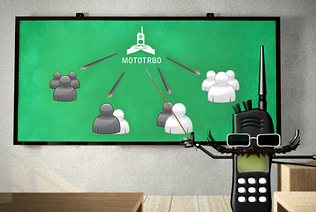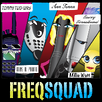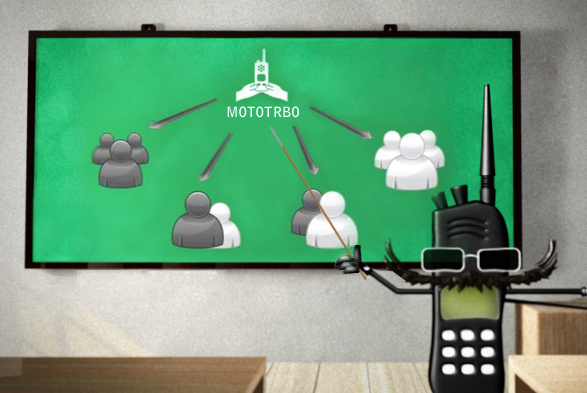Another Lesson from Tommy Two Way: Campus radio systems present a wide range of challenges for radio communications
Building radio systems for educational institutions usually presents itself as: the bigger the campus, the more complex the system. In elementary and middle school, facilities are typically smaller buildings with smaller campuses. As the kids get aggregated into high school the size and complexity of the building changes, not to mention the drastic differences experienced in the environment, too. Each city or district can be different, but it’s common for simplex radio to radio communications to suffice in elementary and middle schools. Coverage is limited to the distance of the portables talking with each other. As we get into the High School level, coverage issues are typically encountered that require solutions to ensure communications.
High Schools, like many educational institutions, are built with brick and mortar. Along with that you’ll see the hallways lined with metal lockers. What a great environment for radio, right? Wrong. The materials used in schools, including some of the energy efficient glass, create some of the most challenging environments known to radio.
When you add several more buildings, dorms, labs and administration offices you’re now lending yourself to the likes of a college campus situation—which is even more challenging to cover with a radio system. Luckily, there can be no worries on the radio part, if you’ve been educated correctly. With a digital mobile radio option, such as the Motorola MOTOTRBO system, the actual radio system can grow with your needs. If you're starting with radio to radio coverage (think one path or I talk, you listen), we can enhance that by adding a repeater. A repeater does just what it states in its name; it takes an incoming radio signal and rebroadcasts it out to other users, typically at higher power with an antenna that has higher elevation. By centrally locating the repeater we can help to insure that if your portable can talk into the repeater, the repeater can rebroadcast your voice to the other user in another part of the building.
system, the actual radio system can grow with your needs. If you're starting with radio to radio coverage (think one path or I talk, you listen), we can enhance that by adding a repeater. A repeater does just what it states in its name; it takes an incoming radio signal and rebroadcasts it out to other users, typically at higher power with an antenna that has higher elevation. By centrally locating the repeater we can help to insure that if your portable can talk into the repeater, the repeater can rebroadcast your voice to the other user in another part of the building.
This will now start increasing the number of users which increases the need for another channel. Well with MOTOTRBO, that one radio repeater you bought actually has two separate talk paths included. No need to obtain additional frequencies. But you may ask, "What about a District wide solution?" Imagine being at one school talking to another school over the radio system. With digital, your own system is now backed up with UPS (Uninterruptable Power Supply) and not reliant on the cellular carriers in an outage. In addition to this great wide area system, you're given the option to add the buses (transportation services) to it. This system can leverage the infrastructure you purchased, to have your buses communicate with dispatch and with third party applications. So the public can actually watch the route of your specific bus to insure that parents know where their child is all the way to school and back.
For College and Universities it can get even more complex. The vast nature of the campus geography creates bigger obstacles. The single site repeater may become a large “Trunking” system. Trunking allows multiple channels to be connected together in a seamless system. This trunking not only allows for more users, but know I can tie multiple trunking systems together to create a wide area network for my radio. I can leverage the campus’ data network or WAN and carry voice traffic across town and key up various locations to insure my voice is heard where it is needed.
MOTOTRBO is just that radio platform. From basic radio to wide area campus coverage, proper design will lead to the right solution for the right reason. As I always say, "Stay smart my friends, stick with digital!"
-Tommy
Tommy Two Way is another member of the FREQ Squad! Tommy’s been around the block and back. He’s a techy old timer who’s been active since the beginning of two way radio. He thinks he’s pretty smart, often saying, “I don’t just talk the talk, I can walk the walk.”—using his mustache as an indication of his many years of wisdom. We urge you to try and stump him with technical questions!
Have No Fear, The FREQ Squad Is Here! If you haven't already heard, the FREQ (“Freek”) Squad are now part of ChiComm's team. They'll be popping in every now and then on the blog to give you helpful hints and tell you about the latest happenings for all things 'freq-y & geeky'. They'll be sharing valuable information related to two-way communications equipment & accessories, important announcements about products, promotions, regulations and answers to frequently asked questions. For bio’s on each member click here. They also have their own twitter handle:@ccFREQsquad
If you haven't already heard, the FREQ (“Freek”) Squad are now part of ChiComm's team. They'll be popping in every now and then on the blog to give you helpful hints and tell you about the latest happenings for all things 'freq-y & geeky'. They'll be sharing valuable information related to two-way communications equipment & accessories, important announcements about products, promotions, regulations and answers to frequently asked questions. For bio’s on each member click here. They also have their own twitter handle:@ccFREQsquad
Have other questions about broadband, digital radio, or narrowbanding? Use the comment box below or read our other articles that have answers to many FAQ's!



